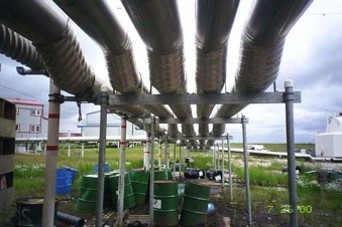Water and wastewater piping in cold northern climates must focus on keeping the water contained within them a fluid. Techniques to maintain fluidity include insulated jacketed pipe, heating (glycol or resistive), or maintained water motion. Further, consideration must be aware of presence of permafrost or seasonal frost that may result in differential ground movement.
In cold regions where temperatures are below 0°C for the majority of the year, freeze protection of water and wastewater infrastructure is paramount. Techniques used are active and passive, or a combination of the two. Selection of the types of freeze protection must consider the environment and community. In many communities, the ground conditions do not allow this infrastructure to be buried and further consideration must be given to local transportation patterns and physical access. Therefore, design of distribution/collection infrastructure in cold regions requires the design engineer to consider cold as a design driver.
At the end of this lecture students will be able to:
- Identify water and wastewater piping alternatives in cold regions
- Identify need for freeze protection in water and wastewater infrastructure
- Weigh the balance between active and passive freeze protection



